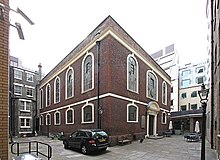
Britain’s oldest synagogue in continuous use faces an “existential threat” if proposals to build two nearby high-rise office blocks in the City of London are given the go ahead.
Bevis Marks – known as the “cathedral synagogue” of UK Jewry – is a Grade 1 Listed heritage building of international significance which on Saturday (September 4) celebrates 320 years of regular services. Initially for those who lived in the City of London, it is now a centre of worship for people from all over the world.
It was built in 1701 in the Ward of Aldgate after the Jews (banished from England by Edward 1 in 1290) were allowed back by Oliver Cromwell. The synagogue has survived the Blitz in World War Two and two IRA bomb attacks in the 1990s. Today it is the home of UK’s Spanish and Portuguese Jewish community and is the only non-Christian house of worship in the City of London.
Now the future of the historic synagogue is up in the air. Developers are proposing to build two high-rise offices directly next door – a 21-storey building in Creechurch Lane and a 48-floor tower in Bury Street. A decision is expected in early October. The cumulative impact, with other buildings built or agreed, will mean sunlight (apart from one hour during the day) will be completely blocked out, making daily services almost impossible.
Historic England has strongly criticised the City of London planning department about the local authority’s policies and proposals for future land use in the area. In a letter, it said: “We believe that fundamental shortcomings in the draft Plan risk encouraging development that will seriously harm the significance of the City’s historic environment, including some of the country’s most important heritage assets (Bevis Marks). In its current form we consider that the draft Plan should not be considered sound”.
Shalom Morris, Rabbi for Bevis Marks, said: “While each new development on its own is unacceptable, all of them together would be catastrophic. The very survival of our great synagogue as a place of worship is at stake.
“We find ourselves as a community alarmed and frustrated that the City policy of focusing tall, high-density development in the Eastern City Cluster has failed to take into account the importance and extreme sensitivity of this Grade I listed synagogue. It represents the unique historic connection between the Jewish community and Britain, and plays such a vital role in London’s heritage.
“Not only will light be blocked, on which the building depends for ambiance, spirituality, and atmosphere, but the very foundations will be at risk. Yet the Jewish community’s British heritage is treated by the planners and developers as just another building”.
Jonathan Solomons, Chair of Bevis Marks Synagogue, said: “Due to the pandemic, there’s already unfortunately a surplus of office space in the City so it doesn’t need another tower block. We’ve been good neighbours for many years and tolerated new developments but these latest applications are a step too far, riding roughshod over cultural sensitivities. Enough is enough.
“The City of London Corporation has no comprehensive framework in place to identify heritage features of outstanding importance within or near the cluster. They are leaving us to the mercy of individual site owners who come forward randomly – put applications in – change them – don’t change them – push them – abandon them – build them – don’t build them. This is a piecemeal and opportunistic approach that threatens not just Jewish but everyone’s heritage.”
Former Lord Mayor of London and former City of London Planning Committee member Sir Michael Bear added: “I have been an ardent supporter of the City’s policy for increasing the modern office stock in the City and the principle of appropriately sited tall buildings. I believe the City has steered a responsible course in this respect, balancing the many competing demands and challenges of creating a global financial powerhouse in a medieval street pattern.
“However, I am both bewildered and perplexed at the way that the genuine considerations of heritage and the impacts of wind, light and community have been treated. This is a total disregard for one of the only surviving examples of an intact Wren style City place of worship with original interior.”
Multiple reports submitted to the City of London Corporation’s planning committee show current light levels are “dangerously low”. The most significant feature of the synagogue, known worldwide, is that it is lit by up to 240 candles. These were supplemented in 1928 by limited electric lighting, which now cannot be enhanced due to restrictions enforced on Grade 1 listed buildings.









